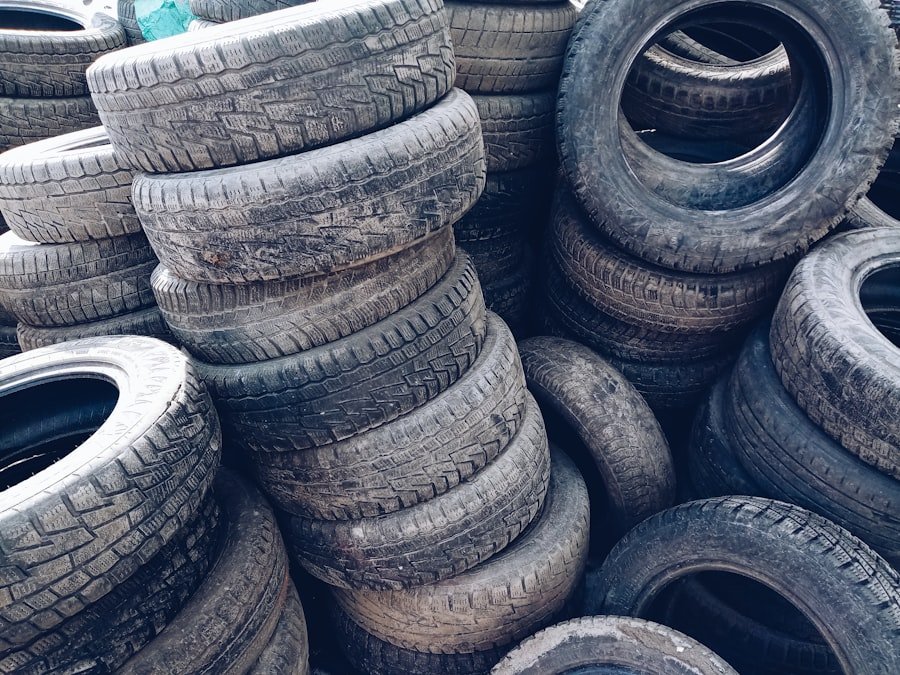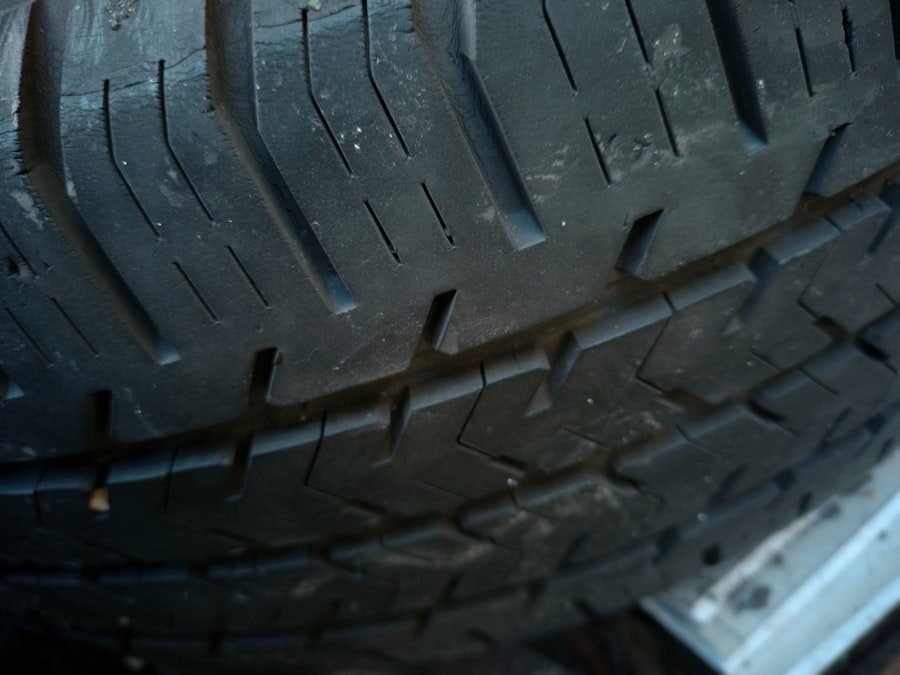Tire tread depth is a critical aspect of vehicle safety and performance, as it directly influences traction, handling, and braking capabilities. The tread on a tire is the part that makes contact with the road, and its depth can significantly affect how well a vehicle grips the surface beneath it. Tread depth is typically measured in 32nds of an inch, with new tires generally having a depth of around 10/32 to 12/32 inches.
As tires wear down, their tread depth decreases, which can lead to diminished performance in various driving conditions. The design of tire tread patterns also plays a vital role in how effectively a tire performs. Different tread patterns are engineered for specific purposes, such as all-season, winter, or performance tires.
Each type has unique characteristics that enhance grip in various conditions, such as wet or snowy roads. Understanding the importance of maintaining adequate tread depth is essential for ensuring that tires can perform optimally throughout their lifespan.
Key Takeaways
- Tire tread depth is the measurement of the vertical depth of the tire’s grooves
- Checking tire tread is important for maintaining traction, handling, and safety on the road
- Visual inspection of tire tread involves looking for uneven wear, bald spots, or foreign objects
- Using a penny to check tread depth involves inserting the coin upside down into the tread grooves
- Using a tread depth gauge provides a more accurate measurement of tire tread depth
Importance of Checking Tire Tread
Regularly checking tire tread depth is crucial for several reasons, primarily related to safety and vehicle performance. Adequate tread depth ensures that tires can effectively channel water away from the contact patch, reducing the risk of hydroplaning during wet conditions. When tires are worn down, their ability to disperse water diminishes, leading to a higher likelihood of losing control on slick surfaces.
This is particularly important for drivers who frequently navigate rainy or snowy environments. Moreover, maintaining proper tire tread depth contributes to better fuel efficiency. Tires with insufficient tread can create more rolling resistance, which forces the engine to work harder and consume more fuel.
This not only increases operating costs but also has environmental implications due to higher emissions. By regularly checking and maintaining tire tread depth, drivers can enhance their vehicle’s overall efficiency while promoting safer driving conditions.
Visual Inspection of Tire Tread

Conducting a visual inspection of tire tread is a straightforward yet effective method for assessing tire health. Drivers should regularly examine their tires for signs of uneven wear, cracks, or other visible damage. Uneven wear patterns can indicate issues such as misalignment or improper inflation, which may require professional attention.
Additionally, checking for foreign objects lodged in the tread can help prevent further damage and ensure optimal performance. During a visual inspection, it is essential to look for indicators of tread wear, such as wear bars or indicators molded into the tire itself. These bars become visible when the tread has worn down to a certain level, signaling that it may be time for replacement.
By incorporating regular visual inspections into their maintenance routine, drivers can catch potential issues early and address them before they escalate into more significant problems.
Using a Penny to Check Tread Depth
| Tread Depth | Measurement |
|---|---|
| New Tire | 10/32 inch |
| Replace Tire | 2/32 inch |
| Penny Test | 2/32 inch |
One of the simplest methods for checking tire tread depth at home involves using a penny. This method is not only easy but also requires no specialized tools. To perform this test, drivers should take a penny and insert it into the tread grooves with Lincoln’s head facing down.
If the top of Lincoln’s head is visible above the tread, it indicates that the tread depth is insufficient and that the tires may need replacing. This penny test provides a quick visual reference for assessing tire health. However, while it can give a general idea of tread depth, it may not provide precise measurements.
For those who want a more accurate assessment, using a dedicated tread depth gauge is recommended. Nonetheless, the penny test serves as an accessible starting point for drivers who want to ensure their tires are safe for use.
Using a Tread Depth Gauge
For those seeking a more accurate measurement of tire tread depth, a tread depth gauge is an invaluable tool. These gauges are designed specifically for measuring the depth of tire grooves and can provide readings in both metric and imperial units.
Tread depth gauges come in various forms, from simple mechanical devices to digital models that offer precise readings. Some advanced models even include features such as built-in temperature sensors or alerts for low tread levels. By utilizing a tread depth gauge regularly, drivers can monitor their tires’ condition more accurately and make informed decisions about maintenance or replacement.
Signs of Low Tire Tread

Recognizing the signs of low tire tread is essential for maintaining vehicle safety and performance. One of the most apparent indicators is reduced traction during wet or slippery conditions; if a vehicle feels unstable or skids easily when driving in rain or snow, it may be time to check the tire tread. Additionally, drivers may notice increased stopping distances when braking, which can be attributed to insufficient grip on the road.
Another sign of low tire tread is uneven wear patterns across the tire surface. If certain areas appear more worn than others, it could indicate alignment issues or improper inflation. Drivers should also be vigilant for any visible damage to the tires, such as cracks or bulges, which can further compromise safety and performance.
Regularly monitoring these signs can help prevent accidents and ensure that vehicles remain roadworthy.
Effects of Low Tire Tread
The effects of low tire tread extend beyond mere safety concerns; they can also impact vehicle performance and longevity. Tires with insufficient tread depth are more prone to punctures and blowouts due to reduced structural integrity. This not only poses a risk to driver safety but can also lead to costly repairs or replacements if damage occurs.
In addition to safety risks, low tire tread can negatively affect fuel efficiency. As mentioned earlier, worn tires create increased rolling resistance, which forces engines to work harder and consume more fuel. This inefficiency can lead to higher fuel costs over time and contribute to greater environmental impact due to increased emissions.
Therefore, maintaining adequate tire tread is not only crucial for safety but also for economic and environmental reasons.
Safety Risks of Driving on Low Tire Tread
Driving on low tire tread presents significant safety risks that cannot be overlooked. One of the most critical dangers is reduced traction during adverse weather conditions. When tires lack sufficient tread depth, they struggle to grip wet or icy surfaces effectively, increasing the likelihood of skidding or losing control of the vehicle.
This risk is particularly pronounced during heavy rain or snowfall when road conditions are already compromised. Moreover, low tire tread can lead to longer stopping distances, which can be catastrophic in emergency situations. A vehicle with worn tires may take significantly longer to come to a complete stop compared to one with adequate tread depth.
This delay can result in collisions that could have been avoided with better traction and braking performance. The combination of these factors underscores the importance of regularly checking tire tread and addressing any issues promptly.
Tips for Maintaining Proper Tire Tread
Maintaining proper tire tread requires proactive measures that go beyond occasional checks. One essential tip is to rotate tires regularly according to the manufacturer’s recommendations. Tire rotation helps ensure even wear across all four tires, extending their lifespan and maintaining optimal performance.
Typically, tires should be rotated every 5,000 to 7,500 miles, but this can vary based on driving habits and vehicle type. Another critical aspect of tire maintenance is ensuring proper inflation levels. Under-inflated tires can wear unevenly and lead to decreased fuel efficiency while over-inflated tires may result in reduced traction and increased risk of blowouts.
Drivers should regularly check their tire pressure using a reliable gauge and adjust it according to the specifications outlined in the vehicle’s owner manual. By combining regular rotations with proper inflation practices, drivers can significantly enhance their tires’ longevity and performance.
When to Replace Tires
Determining when to replace tires is an essential aspect of vehicle maintenance that requires careful consideration of several factors. While many experts recommend replacing tires when they reach 2/32 inches of tread depth, other indicators may suggest it’s time for new tires even if they have some tread remaining. For instance, if tires exhibit visible signs of damage such as cracks or bulges, they should be replaced immediately regardless of tread depth.
Additionally, age plays a crucial role in tire replacement decisions. Even if tires appear to have adequate tread depth, they may still be unsafe if they are older than six years due to rubber degradation over time. Many manufacturers recommend replacing tires every six to ten years based on age alone, regardless of wear patterns or remaining tread depth.
Regular inspections by professionals can help identify when it’s time for new tires based on both age and condition.
Importance of Regularly Checking Tire Tread
Regularly checking tire tread is an essential practice that contributes significantly to vehicle safety and performance. By understanding how to assess tire health through visual inspections, penny tests, and specialized gauges, drivers can make informed decisions about maintenance and replacement needs. The implications of low tire tread extend beyond safety concerns; they also affect fuel efficiency and overall vehicle longevity.
Incorporating routine checks into regular vehicle maintenance not only enhances safety but also promotes responsible driving practices that benefit both drivers and the environment. By prioritizing tire health through consistent monitoring and proactive maintenance strategies, drivers can ensure their vehicles remain safe and efficient on the road.
If you’re looking for more tips on maintaining your vehicle, you may also be interested in this article on whether floor epoxy is worth the investment. Just like checking your tire tread, investing in floor epoxy can help prolong the life of your floors and protect them from wear and tear.
FAQs
What is tire tread?
Tire tread refers to the pattern of grooves and ridges on the surface of a tire that provides traction and helps the tire grip the road.
Why is it important to have sufficient tire tread?
Sufficient tire tread is important for maintaining traction and grip on the road, especially in wet or slippery conditions. It also helps to prevent hydroplaning and provides better handling and braking.
How can I tell if my tire tread is low?
You can tell if your tire tread is low by using the penny test or the tread wear indicator bars on the tire. The penny test involves inserting a penny into the tread groove with Lincoln’s head upside down. If you can see the top of Lincoln’s head, the tread is too low. Tread wear indicator bars are raised rubber bars that appear in the grooves when the tread is worn down.
What is the minimum tread depth for tires?
The minimum tread depth for tires is 2/32 of an inch. Tires with less than this amount of tread are considered unsafe and should be replaced.
How often should I check my tire tread depth?
It is recommended to check your tire tread depth at least once a month, especially before long trips or during seasonal changes. Regular checks can help ensure your tires are safe and in good condition.

